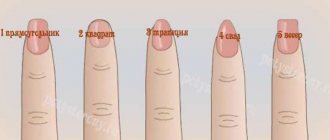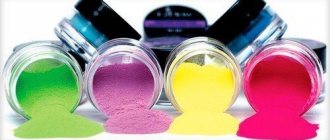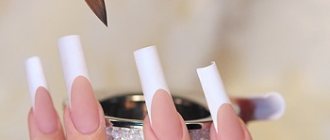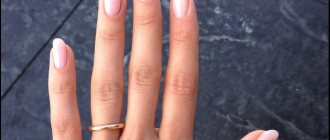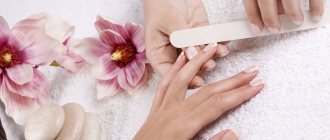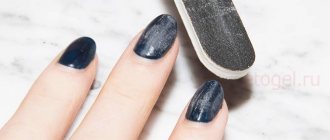Home / Design
Share on Facebook VKontakte Twitter Odnoklassniki
The word pipe comes from America; translated from English it means tube. Indeed, if you look at the “pipe” shape in cross-section, it will remind you of a straw.
This form of nails has not gone out of fashion for many years; it is suitable for everyday life, for working in the office, for going out and just to please yourself or surprise others with jewelry-made nails.
Also, the “pipe” nail shape is very popular among young and adult women; it is actively used by manicurists for design, as well as one of the main styles in nail aesthetics competitions.
For which nails is the pipe shape suitable?
The “pipe” style looks great on all shapes of the nail plate; the stylish “pipe” is especially suitable for women with short fingers. This type of nail extension visually lengthens your fingers, makes them very elegant and fashionable, you will definitely be noticed and complimented on your well-groomed hands.
The basis for creating the “pipe” style was taken from two shapes: almond-shaped and square.
Important rules in shaping the pipe shape
The pipe shape is quite complex in its “architecture”; to create it you need to follow clear rules:
- The pipe form is not performed on tips;
- Correct installation of the substrate (the substrate should not look very down or very high up);
- Follow the technique of washing down stress areas;
- Shape the arch in a timely manner; the bend of the arch should be at least 50% (of the full circle);
- In time, clamp the stress area in the free edge of the nail;
- Correctly attaching the highest point of the artificial nail (apex). At this point, a thickness is formed that, under load, will protect the nail from cracks and prevent it from breaking. It is in the stress zone that the apex is modeled;
- Accurately file down the sides of the nail (they must be perfectly parallel).
Features of manicure
This design looks very feminine, it visually lengthens the fingers, making the hands look thin and beautiful.
The main thing is not to overdo it with the length, otherwise it will look vulgar.
The working material for Pipe nail extensions is acrylic or gel.
In this manicure, nails can be of three shapes: beveled square, rounded square or oval.
Important! Correction is necessary every 3 weeks. After this time, the plate takes on an almond shape.
Advantages
- aesthetic appearance – pipe nails look elegant and feminine and do not go out of fashion;
- visual lengthening of fingers;
- stability - ensured due to the deep bend of the arch and reinforcement along the upper edge along the entire plate;
- Possibility to choose any design and length.
Flaws
- the harmfulness of artificial materials - after removing them, you will need to carry out restorative procedures for the nails;
- complexity of execution and duration (therefore, an experienced master with good perseverance is needed);
- the possibility of problems arising during correction - it is difficult to maintain the created shape.
https://youtu.be/https://www.youtube.com/watch?v=JWuPn-A5hwI
Step-by-step extension of the pipe shape
- Prepare your work area. It should be spacious, it should fit all working tools, additional lighting (desk lamp) and a UV lamp. The workplace should be comfortable for you and for the girl for whom you will be extending pipe nails. The growth process is not fast. Therefore, nothing should bother you.
- Before extensions, always disinfect tools and hands, and also wipe the work surface from dust and used materials.
- File the natural nail so that the base (template) fits well under it.
- Degrease the natural nail with primer or bonder.
- Take the template and place it under the free edge of the nail, secure it in a cone shape and apply the gel base (base) to it. Give the length and width of the nail shape. Dry in a lamp for 1-2 minutes (it all depends on the power of your lamp).
- Apply the modeling gel, while drying in the lamp, clamp the free edge in the stress area with special tweezers to create a bend (C-bend). Dry it.
- Remove the template and adhesive layer. File down the sides. The angle of the cut is 45 degrees (hold the nail file at this angle).
- File and polish the artificial nail. Remove excess gel from it, and also remove dust with a brush. Then apply the “finish” gel and dry it in a lamp.
- Remove the sticky layer. The “pipe” shape is ready.
Step-by-step modeling technique
The extension process is long, so the master should not be distracted by anything. Before starting a manicure, the workplace is cleaned, hands and tools are disinfected, and additional lighting is organized.
The nail plates are filed so that the base fits well on them: it should look as natural as possible and not stick out.
Acrylic extensions
After preliminary preparation, perform the following manipulations:
- apply a primer for degreasing, if necessary, a fresher;
- the backing, rolled into a cone, is applied to the nail;
- the finger is wetted in the monomer;
- distribute acrylic powder over the plate, making the correct design;
- clamp the side edges with pliers;
- wait until the material dries;
- give the required shape with an 80/100 grit file, making parallel edges and beveled ends;
- polished to a shine.
Gel extensions
Manicure is performed using this method, following the following recommendations:
- apply bonder and primer;
- apply a cone shape, cover with base gel, giving the required length and width of the nail;
- dry with a UV lamp for 2 minutes;
- apply a layer of modeling gel;
- pinch with tongs and dry for 1 minute;
- remove the backing and put a clamp to make a tube;
- polymerize the material under a lamp;
- remove the sticky layer;
- file and polish the artificial plate;
- degrease;
- Cover with finishing gel and dry with a lamp, remove the sticky part.
Possible disadvantages
With proper extension, it has no disadvantages. But if the extension process is not carried out professionally, this form can break and cause a lot of inconvenience to its owner (including injury). Also, it is worth including the harmfulness of materials, gel and acrylic. Even modern technologies in the development of materials for extensions do not allow the natural nail plate to “breathe”. Each extension is a little stress for nails, even if it is done perfectly. Be that as it may, artificial materials contain chemical additives and make the nail plate heavier.
Manifestation of classics in the form of “Pipe” nails
Many girls dream of having long nails, but for various reasons they cannot afford it.
Fortunately, modern extension technologies solve all these problems. Nail service professionals are constantly developing new original designs and offering their clients interesting nail shapes. A correctly performed extension procedure can visually correct even the most inexpressive natural nails, turning them into a standard of perfection.
The Pipe nail shape is one of the successful types of nail extensions that combine classic elegance and practicality.
Features of “Pipe” nails
Despite the fact that naturalness and naturalness have recently become a trend, artificial nails are still popular with many representatives of the fair half of humanity.
If you are a fan of medium or long lengths, but want such nails to look as natural as possible, then “Pipe” style extensions are an ideal option for such purposes. Let's take a closer look at the universal and strong shape, which perfectly emphasizes the elegance of women's hands.
Vivid photos and an excellent video tutorial, presented to your attention at the end of the article, will help you visually appreciate the beauty of impeccable outlines.
The “Pipe” form of extended nails, developed by Victoria Klopotova, is distinguished by its durability and attractive appearance. Creative modeling of the nail plate is a great way to make naturally not too long fingers more elongated and graceful.
Translated from English, the word “Pipe” means “tube”. And indeed, if you look at the nail from the free edge, it illustrates its name.
You can verify this at the end of the article by looking at the photo where tube nails are presented in all their glory.
Pipe nail modeling technique
The technology for creating an interesting shape, in which the free edge has the outline of an arch, is somewhat different from modeling other nails. When forming a “Pipe”, the master should follow important rules.
- A special feature of “Pipe” nails is the transverse arch of the nail. It is also called the “C-bend”. If usually when modeling an artificial nail plate, the C-curve is no more than 30% of the full circle, then the “Pipe” shape is created with a transverse arch of 50% or more. That is why the free edge appears in the form of a tube. This original bend is created when the extension material begins to polymerize, but still has a fairly soft and pliable texture. At this moment, it is necessary to squeeze the sides of the nail in the stress area, giving the tip an arch shape. If this is not done, the outline of the free edge will remain trapezoidal, and the C-curve will be flat. Obviously, tube nails are more resistant to breakage than other types of tip extensions .
- When filing, it is necessary that the sides of the nail are parallel to each other. When correcting the free edge, the nail file should be held at an angle of 45° relative to these parallel lines.
- When fixing the paper template, it is recommended to lift it slightly so that the free edge faces up. Then the unique “Pipe” shape will look just perfect.
- It is important to understand that tube nails can only be modeled using gel or acrylic. It is impossible to perform such extensions using tips.
- “Pipe” differs from other nail models in that the tip can be designed in any way you like. These can be oval, almond-shaped, rectangular, stiletto-shaped and other free edge shapes. Looking at the photo, you will be convinced that all these variations look great due to the semicircular bend, giving the fingers some sophistication and lightness.
What nail art is suitable for the Pipe nail shape?
Tube-shaped marigolds look luxurious and elegant, decorating women's hands. This model has perfect shapes and lines, so it does not need flashy decor.
Nails in the “Pipe” style are appropriate among the everyday bustle of a large office if they are covered with a plain pastel-colored varnish. You can also do a French manicure or an unusual, but very stylish lunar design in subdued colors for work.
After all, the dress code of a business lady does not imply bright flashy colors and an abundance of shimmering and shining elements on the nails.
Since the amazing strength of the nail plate allows you to adjust the length, you can create real masterpieces of nail art on such a large area.
For this, lace, pieces of fabric, multi-colored combinations, unusual patterns, semi-precious stones and other decorative elements are used. “Pipe” is often chosen by brides, since its high strength and aesthetic appeal make the shape an ideal option for a wedding.
Appreciate the beauty of extended nails by taking a look at our photo collection, which contains various nail art options.
The final video lesson will be useful and informative even for experienced professionals, not to mention those new to the field of nail service.
The correct technology for modeling a beautiful tube shape requires adherence to certain geometry rules and perfect mastery of extension tools.
By learning the art of nail art from classy specialists, you can become a virtuoso professional!
Source: https://HomeManicure.ru/design/forma-nogtej-pajp.html
Pipe shaped nail design
painting
The “pipe” shape is a real find for craftsmen. After all, it allows you to create real artistic masterpieces. There are many types of nail painting. Among them, Chinese painting is especially popular: gorgeous flowers, incredible effects, animals, delicate undertones turning into wonderful bouquets, and this is just a little of what the Chinese painting technique can create on “pipe” shaped nails.
French on pipe form
But on this form, French manicure can be performed in different versions and color variations.
“Crystal French” looks incredible
This is an extension technique where the free edge of the nail remains transparent and is covered with glitter. Which creates the crystal effect. This design can be complemented with delicate painting or beautiful stones. The only disadvantage of the crystal jacket on the “pipe” form is that when repeated correction, the gel is completely removed from the natural nail and re-built.
Aquarium design
Aquarium design - a three-dimensional effect using an illusory gel, as if all the parts of the design are under glass: beads, pebbles, dried flowers, sequins, mica, foil, etc.
Features of pipe nail shapes
Pipe nails really resemble tubes, because their side edges are parallel, and the free edge of the plate has a 45-degree bevel. You can choose extensions of almost any length; pipe painting looks good on nails.
The pipe shape is modeled on tips using acrylic paint. But many masters also use gel. To form a plate, you must first prepare the nails. To do this, the surface is degreased and filed. Then use a cone shape. Next, acrylic is applied with a round brush according to the shape, and the nail is modeled. It is also important to pinch the side edges as you build, you can use tweezers for this.
The final shape of the nail is given using a file. The stiffener must be modeled until the acrylic polymerizes. For additional shine, you can cover the nail plate with a finishing gel or other decorative coating.
What are pipe nails and how are they done?
Pipe nails have become popular recently. Many women try to take care of their hands, because through a well-chosen nail shape you can convey not only your mood, but also your character and emphasize your individuality. This type of manicure is great not only for wedding celebrations, but also for everyday use.
What are pipe nails?
Let us immediately note that it is possible to create an unusual nail shape called a pipe only using artificial materials.
This option is intended for female representatives who not only value convenience and beauty, but also want to comply with fashion trends.
Looking at the photo of the pipe nail shape, it’s hard not to agree that it looks elegant on any woman’s hands.
Literally translated from a foreign language, “Pipe” means “tube.” This method of designing nail plates is quite original. Acrylic or gel is used as the working material. By the way, they have stiffening ribs, this ensures resistance to fracture. The peculiar shape of the nail plates is appropriate both at a celebration and in everyday life.
And the manicure consists in the fact that each nail combines two shapes at once - these are square sides and a free edge in the form of an oval. Another distinctive feature is that the oval has an arch of ½ part of a circle, the ends are beveled at 450. Looking at the nail plates from the side, you involuntarily notice that they resemble tubes, which is why they received the corresponding name.
Remember the main rule of pipe nail design: the outline of the extended plate should be identical to the anatomical bed and fit well with the shape of the elements of the brush. By following this rule, you can count on a positive result. It will please the eye for a long time.
If everything is done correctly, the fingers will be visually lengthened, this cannot but give grace to women’s hands.
When you come across a photo of pipe nails on the Internet, or see a similar manicure on your friends, you want such a design for yourself. The implementation process can hardly be called simple.
It will be better if you entrust this matter to a real master, who will make sure that all the necessary ratios are strictly observed.
How is a pipe nail shape made?
The main material used to create pipe nail shapes has always been acrylic paste, but now gel polish has also appeared. It all starts with preparing the nail plates and applying the base.
The next step is to place a cone-shaped shape under the free part of the nail plate, then lay out the backing. Thus, the required length and shape of the artificial nail is formed.
By the way, its strength directly depends on its width.
The master must make sure that the resulting nail bed looks like an oval. In principle, the extension procedure itself is not much different from similar techniques for creating an artificial nail.
First, the working material is applied in the cuticle area, then the free edge, and after the stress zone, the master moves on to the “tunnel” line.
The main criterion for the correct design of pipe-shaped nails is that the C-shaped bend, together with a transverse arch, should form half a circle.
There are situations when the described bend decreases and becomes less recessed. In this case, the nail plate is extended to half the nail circle, only 20%. Rigidity in this case is provided by the central line of the nail curved inward.
The choice of a specialist should be approached very responsibly; not everyone can achieve the desired effect.
Disadvantages of pipe shaped nails
Every good thing has a downside, and pipe nail extensions are no exception. Firstly, if you use acrylic paste, be prepared to endure a strong, unpleasant odor throughout the entire procedure.
Secondly, the material contains a dangerous component - methyl methacrylate. It is worth noting that it causes complex allergic reactions in some people. If you are inclined to do this, be sure to warn the master.
This problem can be solved by replacing acrylic with gel polish or using a more modern acrylic paste (new generation).
It is also important to know that although acrylic is easier to remove from nails than gel polish, the coating can easily turn yellow during wear, and it will be extremely difficult to change anything.
You should not miss the fact that any artificial material applied to the nail interferes with normal nutrition, growth, and development of the nail plate. They need to be given time to rest, removing the coating completely. At the same time, high-intensity care is provided.
In order to provide additional nutrition, strengthen and restore the nail, a variety of cosmetic procedures are performed.
Important nuances associated with pipe nail extensions
A true master of his craft knows that it is possible to give the nail the desired shape only after the acrylic paste has completely hardened. The ideally rounded shape is ensured by the formation of bevels.
The result of filing and polishing is important, and perhaps the main thing. The plates must be clearly parallel to each other along the side edges, and also equally rounded along the free edge.
Upon completion of the extension process, the artificial plate is polished to a shine and prepared for further decoration.
As for the photo of pipe nail design, as we see, this form is suitable for design in the form of a jacket, volumetric sculpting, application of reflective particles, as well as multi-color painting. To get a more accurate idea, it’s worth looking at photos of the works of real masters.
If you wish, you can learn how to do your own nail modeling and give yourself an original manicure at home. In this case, you can’t do without thematic videos and master classes.
Source: https://www.stylenews.ru/krasota/chto-takoe-nogti-payp-i-kak-oni-delayutsya/

